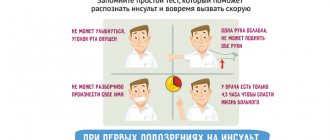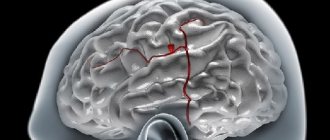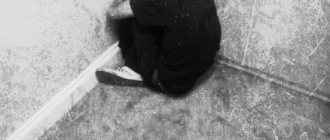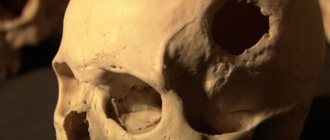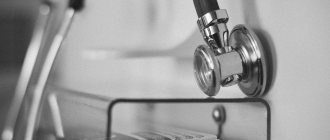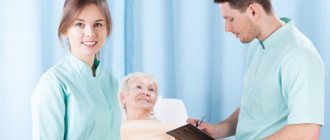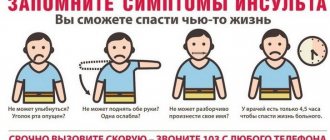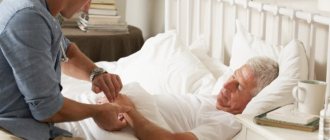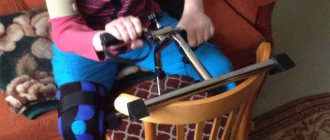Therapy for ischemic stroke
Treatment of ischemic stroke is a long and complex process, which should exclusively be carried out in an inpatient setting. It should be started as quickly as possible. This increases the patient’s chances of saving life and making a full recovery.
The thing is that within 3-6 hours after a stroke, a necrotic focus forms in the brain. If blood circulation is normalized during this period of time, the focus of necrosis can be neutralized.
For these purposes, drugs are used that reduce blood clotting and improve blood supply to the brain.
Therapy for ischemic stroke consists of several stages:
- pre-hospital (calling a doctor, emergency delivery to a medical facility);
- inpatient (attack relief, diagnosis, relapse prevention);
- restorative (medication, manual therapy);
- rehabilitation (attending physiotherapeutic procedures to eliminate the consequences of a stroke).
First of all, they eliminate the threat to life, and after diagnosis, medications are prescribed to improve blood flow, normalize blood pressure, protect neurons from lack of nutrition, prevent brain swelling and relieve symptoms.
A special role is given to measures to restore lost functions, which are continued at home or during sanatorium-resort treatment.
During the rehabilitation period, procedures such as massage, electrical stimulation of muscle tissue, reflexology, acupuncture, pelotherapy and exercise therapy are provided.
It is not uncommon for a patient who has suffered a stroke to require more than a year to fully recover. Successful rehabilitation depends not only on physiotherapeutic procedures and medications, but also on timely assistance.
Rehabilitation program after stroke at the Federal Scientific Center FMBA in Moscow
For patients who have suffered an acute circulatory disorder in the brain, timely, prompt and competent rehabilitation after a stroke is the first and key step on the path to restoring health. It is possible to achieve the maximum clinical effect of rehabilitation only by resorting to the help of experienced specialists.
It is important to understand that rehabilitation after a stroke should begin as early as possible, from the first days of the disease - when the patient’s condition becomes stable. For local hemorrhages that have not spread to a large area of the brain, the patient’s condition stabilizes on the third or fourth day. With the beginning of this period, it becomes possible to begin the rehabilitation process.
In the neurological department of the Federal Scientific and Clinical Center of the Federal Medical and Biological Agency of Russia, rehabilitation of patients after a stroke is carried out by experienced doctors and qualified, specially trained medical personnel. At the Center, patients have the opportunity to successfully restore skills and functions lost as a result of cerebrovascular accidents.
Traditionally, there are three key stages of a rehabilitation program after a stroke:
- First stage: during this period the patient is in a supine position ; Often, with a severe form of stroke, the patient is motionless. During this period, rehabilitation activities are limited by the patient’s condition and consist of systematic turning over, specialized anti-bedsore massage and breathing exercises. Medical rehabilitation specialists constantly talk with the patient, even if he does not have a pronounced reaction to speech: passive listening activates attention, and understanding of speech gradually returns. The first stage of recovery can last from several days to several months, depending on the severity of the stroke.
- Second stage (early): during this period the patient can already perform a certain range of movements, but getting out of bed independently is not yet possible for him . The patient undergoes passive kinesiotherapy (movement treatment - specialized gymnastics, massage), physiotherapy. Rehabilitation specialists are engaged in eliminating aphasia (speech impairment) and restoring the patient’s memory. The early rehabilitation stage can last from several weeks to six months.
- The third stage is the period of late rehabilitation: a period of active restoration of motor, mental, mental, emotional functions and skills . The patient can already do gymnastics independently, tries to sit in bed and get out of it. At this stage, occupational therapy plays an important role (occupational therapy - activities aimed at developing fine manual motor skills). Rehabilitation also includes drug therapy, sessions with a speech therapist and psychologist. The late stage of recovery can take from six months to two years.
At the Federal Scientific and Clinical Center of the Federal Medical and Biological Agency of Russia, the key principle of rehabilitation programs after stroke is an individual approach to restoring the health of each patient. Specialists carefully study the history and clinical picture of the disease in each patient, analyze the degree of brain damage and impairment of basic functions, and assess the severity of the post-stroke condition. After this, an individual treatment regimen and recovery course are developed with preliminary planning of the duration of each stage. The Center also carries out measures to prevent the recurrence of stroke, allowing to consolidate and prolong the obtained therapeutic effect and prevent the risk of new brain damage.
Rehabilitation of patients at the Federal Scientific and Clinical Center of the Federal Medical and Biological Agency of Russia is structured as follows:
- A supervising neurologist, exercise therapy instructor, as well as a psychologist and speech therapist (if necessary) are assigned to the patient.
- Doctors work with the patient every day, using appropriate modern treatment methods: individual and group kinesiotherapy (physical therapy), massage, various types of physiotherapy, including electrical neurostimulation and myostimulation, exercises on simulators with biofeedback, devices for restoring fine motor skills of the hand and movement of the lower extremities, speech therapy classes, consultations with a psychotherapist, neuropsychologist (if necessary) and many other activities.
Comprehensive rehabilitation after a stroke includes a series of activities aimed at:
- restoration of movement function (verticalization, ergotherapy, ensuring gradual restoration of walking; therapeutic massage; physical therapy; physiotherapeutic procedures);
- restoration of speech function and memory (sessions with specialists, aphasiologist, speech therapist);
- restoration of psycho-emotional health (sessions with a psychologist, communication with relatives, non-stressful physical activity).
Health care
World statistics show that most of the time is lost at the pre-hospital stage, since only a few, feeling unwell, call an ambulance.
If such a situation occurs outside the home, then passers-by may simply walk past the victim, thinking that the person has drunk too much. And there is an explanation for this, since the pre-stroke state superficially resembles alcohol intoxication.
The first signs of an ischemic cerebral stroke appear suddenly, “like a bolt from the blue,” when a minute earlier the person had not yet complained of feeling unwell.
Treatment for a stroke begins precisely from the moment when the surrounding people immediately reacted, called an ambulance and competently provided first aid.
First aid during an attack
While the ambulance is on the way, you need to act very quickly, so you will have to perform several actions simultaneously:
- Provide the victim with free breathing. If this happens indoors, you need to open the vents and windows. Remove anything that is squeezing your neck and chest (tie, bra), unfasten the top buttons.
- Place the patient on a comfortable plane so that the head is elevated. This is done to prevent cerebral edema. If you are unconscious, turn your head to the side to prevent vomit from entering your respiratory tract.
- If he has a seizure, remove any dangerous objects that could cause injury and make sure he doesn't bite his tongue. If the person has dentures, try to remove them from the mouth. If you can, secure an object wrapped in cloth between the jaws.
- In case of cardiac arrest, perform chest compressions and artificial respiration.
It is forbidden to give the patient food, drink, and especially medicine, unless you are a qualified physician.
No matter how serious the patient’s condition, you need to remain calm and act clearly. Vanity and unnecessary movements will only slow down the help.
In case of apoplexy, it is extremely important to have time to hospitalize the victim in the first 3-4 hours, examine and begin appropriate therapeutic measures.
Rehabilitation after stroke
To reduce the risk of complications and speed up a person’s return to a full life, it is very important to carry out early rehabilitation at the stage of the acute period of the disease. It includes physical therapy, massage, breathing exercises and, if necessary, restoration of lost functions.
As mentioned earlier, the basis for successful treatment of stroke is the rapid hospitalization of the patient in a medical facility. And if a person’s life is really important to you, you should turn to us for help, because only we carry out hospitalization to the clinic in just 15 minutes! You can call us for help 24 hours a day by calling our hotline.
St. Petersburg neurologist: To save a person with a stroke, act faster - “time = brain”
Most people prefer not to delve into the medical jungle, believing that a stroke will bypass them. It would be nice, of course. But the truth is that every year in Russia, acute cerebral stroke occurs in approximately 450 thousand people. In some regions of the country, 35% of stroke survivors die, and about 20% die within a year. In developed countries, mortality from ischemic stroke in the first 30 days is up to 19%; after a year, 77% of survivors remain. Today, a 40-year-old patient with this diagnosis is no longer uncommon, and after 55, the risk doubles. It is known that women are more at risk of developing a stroke and are more likely to die from its consequences. And their recovery process is longer and more difficult.
In the minds of many, the diagnosis of “stroke” sounds like a death sentence. However, modern medicine, if you seek help in a timely manner, can not only save a person’s life, but even avoid disability.
On International Stroke Prevention Day, the Alexandrovskaya Hospital annually invites St. Petersburg residents to events dedicated to the prevention of this disease. This year, the hospital organized a grandiose quest “Hide from a Stroke.” Its participants will be able to be examined and receive information about how to live to prevent a stroke, and what to do if it does happen. The Deputy Chief Physician of the Alexander Hospital for Neurology, Head of the Vascular Center, Ph.D., tells readers of Doctor Peter about this. Lyudmila Roshkovskaya.
What we should know about stroke
The most important thing is to quickly recognize a stroke and call an ambulance.
If you think a person is having a stroke, ask them to do these simple steps:
- Smile. With a stroke, the smile will be asymmetrical: one corner of the mouth goes down rather than up.
- Say a simple sentence. The person will speak slowly, haltingly, or incoherently.
- Raise your hands. They will not be able to position themselves parallel to each other; one will be lower.
There are other manifestations of a stroke: weakness and numbness of half the body, dizziness, nausea, vomiting, headache, double vision, etc.
If you suspect you or others are having a stroke, call an ambulance immediately. Procrastination, the desire to “lie down”, the reluctance to go to the hospital in this case is like death. The English say: time is brain. That is, the prognosis for the future in case of stroke depends not only on the extent of brain damage, but also on the speed of delivery of a person to the hospital, as well as the quality and volume of high-tech medical care provided in the first hours after the “stroke.”
Why is delay like death?
There are two types of stroke: ischemic and hemorrhagic. This is an acute, that is, a sudden and rapid violation of the blood circulation of the brain due to blockage (atherosclerotic plaque or blood clot - ischemic stroke) or rupture (hemorrhagic stroke) of cerebral vessels. Due to impaired blood circulation, a lack of oxygen occurs. It leads to damage and then death of nerve cells. As a result, the body loses the functions for which the dead cells were responsible. The doctor’s task is: firstly, to restore cerebral blood flow, and secondly, to protect nerve cells from further damage.
The first task in a situation with ischemic stroke is helped by thrombolytics - drugs that dissolve blood clots and restore blood flow; they can prevent damage to nerve cells, and, therefore, cerebral infarction (or significantly reduce its possible size). However, the indications for the use of these drugs are limited primarily by the time period - they can be administered no later than 4.5 hours after the stroke. This means that you need to have time to suspect a stroke, call an ambulance, arrive at the hospital with its help, and establish an accurate diagnosis. Therefore, it is so important to consult a doctor immediately after the first symptoms of the disease appear.
Without oxygen and nutrients (glucose), brain cells begin to die. Neuroprotectors (or cytoprotectors), substances that protect cells from damage, help stop this mechanism. The drugs increase cell activity and promote changes in function: the surviving brain cells will take on the functions of their dead neighbors. Therefore, the doctor selects the necessary protection as early as possible during a stroke.
In addition to therapeutic methods, surgical ones are also used. Carotid endarterectomy, thrombosuction, thrombectomy, embolization of aneurysms, drainage of hematomas, stenting and clipping of vessels and much more are the methods of choice. They can also prevent both first and recurrent strokes. However, each operation has clear indications and contraindications. The decision should be made by a council of a neurologist, neurosurgeon and cardiologist. The timing of surgical treatment is also limited, so, again, it is important not to waste time.
To prevent a second stroke, you need to find the causes of the first
Stroke may recur in every third patient who has had a stroke. And in this case, neurological disorders will be even more serious, and the chances of survival will be less. Therefore, everything must be done to warn him. Secondary prevention begins with establishing the exact cause of the first stroke, since in the vast majority of cases the same cause provokes a second stroke. And the reasons may be different, moreover, there may be several of them. Doctors call them risk factors.
Use of other medications
Therapeutic tactics for stroke are determined based on the general condition of the patient. In severe cases, improvement of blood rheological characteristics is required. For this purpose, Reopoliglucin and protein preparations are prescribed. Against the background of severe ischemic stroke, cerebral edema often develops. To eliminate it, the following medications may be required:
- osmotic and loop diuretics;
- glucose solution;
- magnesium sulfate;
- corticosteroids.
The main goal is dehydration. First, osmotic diuretics are used, and then loop diuretics (Lasix). An obligatory aspect of therapy is the correction of blood pressure. For hypertension, calcium channel blockers and ACE inhibitors may be prescribed. Blood pressure correction is carried out in the early stages before hospitalization. Antihypertensive tablets or solutions may be used.
To normalize the function of external respiration, Eufillin is used. This drug dilates the bronchi. The most common cause of stroke is atherosclerosis of the cerebral arteries. After the acute period subsides, such patients are prescribed lipid-lowering drugs. Statins are the most effective.
The most popular are Atherostat, Simvastatin Zentiva, Zocor, Atoris, Liprimar, Torvacard, Rovacor, Vero-Lovastatin and Cardiostatin.
A statin drug must be taken regularly throughout your life. This reduces the risk of recurrent stroke and improves fat metabolism. For acute stroke, symptomatic therapy is carried out. Antiemetics, painkillers, and anticonvulsants may be used. After laboratory and instrumental studies, if necessary, the treatment regimen is adjusted.

